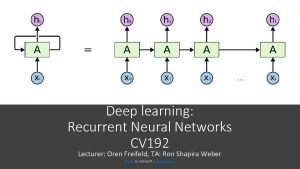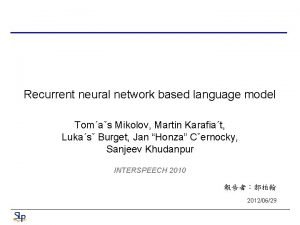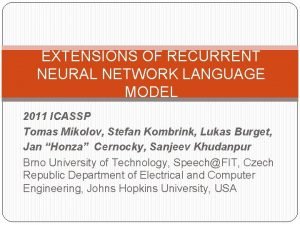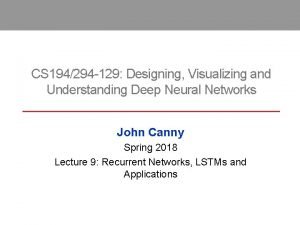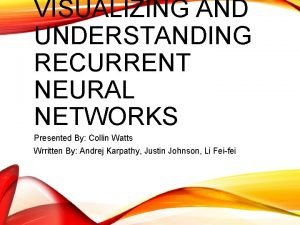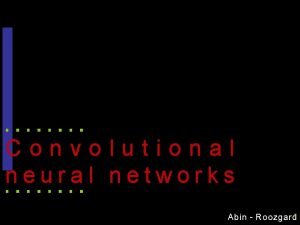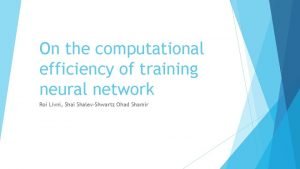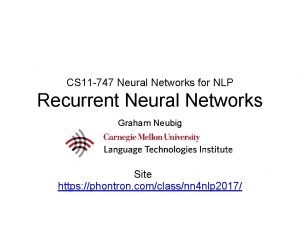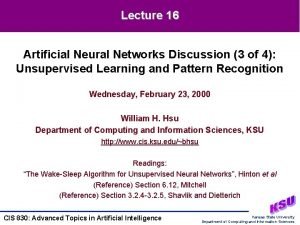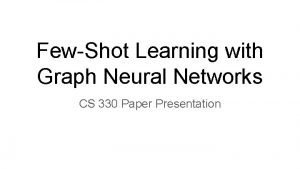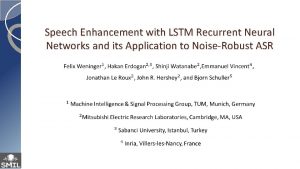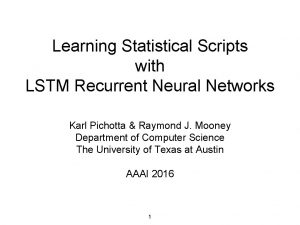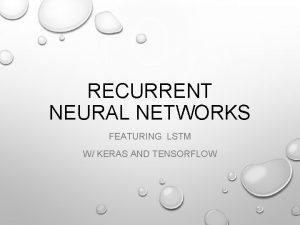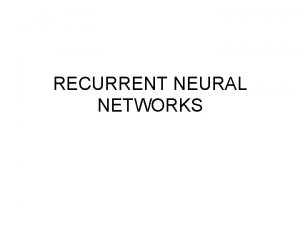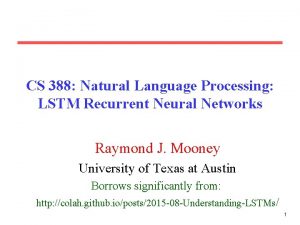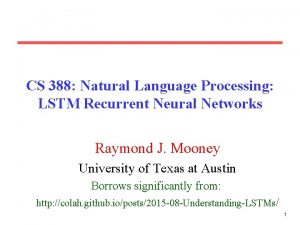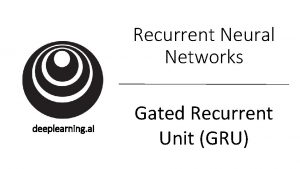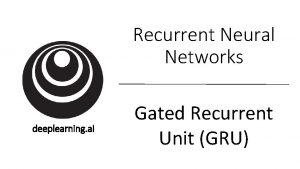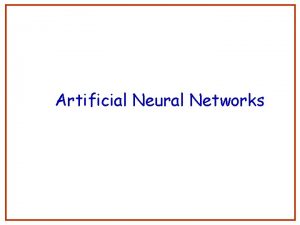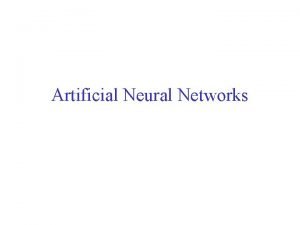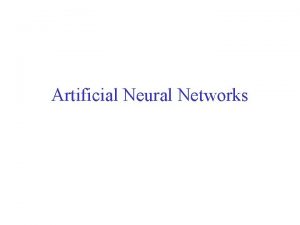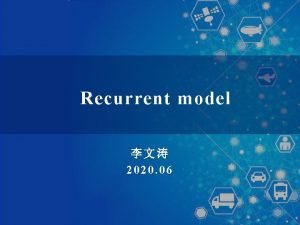Recurrent Neural Networks LSTM Advisor S J Wang























- Slides: 23

Recurrent Neural Networks & LSTM Advisor: S. J. Wang, F. T. Chien Student: M. C. Sun 20150226

Outline • Neural Network • Recurrent Neural Network (RNN) • Introduction • Training • Long Short-Term Memory (LSTM) • Evolution • Architecture • Connectionist Temporal Classification (CTC) • Application • Speech recognition • Architecture

Neural Network • Inspired by human’s neural system • A complicated architecture • With some specific limitations • Ex. DBN, CNN…

Feedforward Neural Network • output hidden Input › › 1 … …… 1 1 h : activation function σ : sigmoid function/ softmax function 4

Training in Neural Network output hidden 1 … …… 1 Input Forward propagation 1 ‧

Training in Neural Network output hidden Input Forward propagation 1 … …… 1 1 Backpropagation

RNN A deepest neural network

Recurrent Neural Network • A network of neurons with feedback connections • For time-varying input • It’s good at temporal processing and sequence learning input time

Recurrent Neural Network • For supervised learning • Training: back propagation through time output hidden Unfolding over time input t=1 t=2 t=3 t=4 t=5

Unidirectional RNN Output Unroll Hidden Input t-1 t t+1 State of hidden node can represent short-term memory by connecting to itself at previous state

Bidirectional RNN

Bidirectional RNN Output Forward States Backward States Input t-1 t t+1

Training in RNN • output k hidden j input t=1 t=2 t=3 t=4 t=5

Training in RNN • output k hidden j input t=1 t=2 t=3 t=4 t=5

Training in RNN • output k hidden j input t=1 Maximal value f’=0. 25 Vanishing gradient problem t=2 t=3 t=4 t=5

LSTM One solution to vanishing gradient when training RNN

Long Short-Term Memory (LSTM) • For conventional RNN, • Hidden state with self-cycle can only represents short-term memory due to the vanishing gradient problem • Invented by Hochreiter & Schmidhuber (1997) • Long short-term memory is designed to allow hidden state to retain important information over longer period of time • Replace neurons’ structure of hidden layer in RNN Reference: Long Short-Term Memory. Sepp Hochreiter, Juergen Schmidhuber. (1997)

Long Short-Term Memory (LSTM)

Constant Error Carrousel (CEC) • t=1 t=2 t=3 t=4 t=5 Self-cycle = 1

Gate • Weight conflict: all data come into nodes included important or irrelevant information • Introduce gate concept • From input to hidden • To protect cell from irrelevant input & storing value in cell • From hidden to output • To protect output from irrelevant cell & output cell’s value

Long Short-Term Memory Structure • LSTM (CEC+gate) • Cell: storing memory • Input gate: protect the cell from irrelevant input • Output gate: protect irrelevant other units from cell • Forget gate: reset storing memory in cell • Peephole connection: improve precise timing

Long Short-Term Memory Structure • By using CEC to achieve long short-tem memory • Learning gates’ weights to get the model

 Rnn
Rnn Rnn andrew ng
Rnn andrew ng Colah lstm
Colah lstm Recurrent neural network based language model
Recurrent neural network based language model Extensions of recurrent neural network language model
Extensions of recurrent neural network language model Cs 231 n
Cs 231 n Visualizing and understanding recurrent networks
Visualizing and understanding recurrent networks Netinsights
Netinsights Neural networks for rf and microwave design
Neural networks for rf and microwave design Convolutional neural networks
Convolutional neural networks Audio super resolution using neural networks
Audio super resolution using neural networks Neural networks and learning machines
Neural networks and learning machines On the computational efficiency of training neural networks
On the computational efficiency of training neural networks Convolutional neural network
Convolutional neural network Mippers
Mippers Visualizing and understanding convolutional networks
Visualizing and understanding convolutional networks Lmu cis
Lmu cis 11-747 neural networks for nlp
11-747 neural networks for nlp Convolutional neural networks for visual recognition
Convolutional neural networks for visual recognition The wake-sleep algorithm for unsupervised neural networks
The wake-sleep algorithm for unsupervised neural networks Tlu perceptron
Tlu perceptron Neural networks and learning machines 3rd edition
Neural networks and learning machines 3rd edition Few shot learning with graph neural networks
Few shot learning with graph neural networks Vc bound
Vc bound


